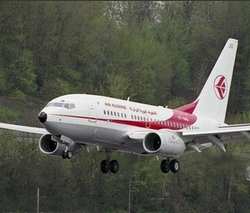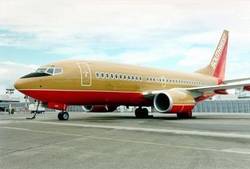Tue, Jun 21, 2005
 Subject: Boeing 737 Series Airplanes
AD/B737/202 (Amdt 1) Center Fuel Tank Limitations 8/2005 TX
Subject: Boeing 737 Series Airplanes
AD/B737/202 (Amdt 1) Center Fuel Tank Limitations 8/2005 TX
Applicability: Model 737-600, -700, -700C, -800, and -900
series airplanes with line numbers prior to 1494.
Requirement: 1. If not previously accomplished in
accordance with AD/B737/202 original issue: Revise the Limitations
Section of the Aircraft Flight Manual (AFM) to include the
following (this may be accomplished by inserting a copy of this
Directive into the AFM):
CERTIFICATE LIMITATIONS
The center tank fuel pumps must be OFF for takeoff if center tank
fuel is less than 5,000 pounds (2,300 kilograms) with the airplanes
readied for initial taxi. Both center tank fuel pump switches must
be selected OFF when center tank fuel quantity reaches
approximately 1,000 pounds (450-500 kilograms) during climb and
cruise or 3,000 pounds (1,400 kilograms) during descent and
landing. The fuel pumps must be positioned OFF at the first
indication of fuel pump low pressure. The center tank fuel quantity
indication system must be operative to dispatch with center tank
mission fuel.

Note: The CONFIG indicator will annunciate when
center tank fuel exceeds 1,600 pounds (726 kilograms) and the
center tank fuel pump switches are OFF. Do not accomplish the
CONFIG non-normal procedure prior to or during takeoff with less
than 5,000 pounds (2,300 kilograms) of center tank fuel or during
descent and landing with less than 3,000 pounds (1,400 kilograms)
of center tank fuel.
In a low fuel situation, both center tank pumps may be selected ON
and all center tank fuel may be used. If the main tanks are not
full, the zero fuel gross weight of the airplanes plus the weight
of center tank fuel may exceed the maximum zero fuel gross weight
by up to 5,000 pounds (2,300 kilograms) for takeoff, climb and
cruise and up to 3,000 pounds (1,400 kilograms) for descent and
landing, provided that the effects of balance (CG) have been
considered. If a center tank fuel pump fails with fuel in the
center tank, accomplish the FUEL PUMP LOW PRESSURE non-normal
procedure. When defueling center or main wing tanks, the Fuel Pump
Low Pressure indication lights must be monitored and the fuel pumps
positioned to OFF at the first indication of fuel pump low
pressure. Defueling with passengers on board is prohibited.
 The limitations contained in this
Directive supersede any conflicting basic Aircraft Flight Manual
limitations.
The limitations contained in this
Directive supersede any conflicting basic Aircraft Flight Manual
limitations.
Accomplishment of Requirement 2 of AD/B737/198 or Requirement 1.b.
of AD/B737/198 Amdt 1 is acceptable for compliance with the
requirements of this Directive. This Directive does not require
that those actions be repeated unless the terminating actions
specified in Requirement 6 of AD/B737/198 or Requirement 3 of
AD/B737/198 Amdt 1 have been accomplished. Accomplishment of the
terminating actions specified in Requirement 6 of AD/B737/198 or
Requirement and 3 of AD/B737/198 Amdt 1, does not allow removal of
the AFM revisions required by this Directive.
2. For mixed fleet operations (ie operators with aircraft with line
number 1494 and subsequent together with aircraft with line number
below 1494) install a placard on the flight deck of aircraft that
do not have automatic fuel pump shut-off system installed to alert
the crew that the Requirement 1 procedures must be followed on that
aircraft stating: “AD/B737/202 fuel usage restrictions
required” For aircraft that have a placard required by
AD/B737/198 or AD/B737/198 Amdt 1, that placard can be used to
fulfill this requirement for mixed fleet operations. Note: FAA
Emergency AD 2002-24-51 and FAA AMOC Letter 140S-04-105 dated 28
May 2004 refer.
Compliance: For Requirement 1 and 2 - Before 31
July 2005. This Amendment becomes effective on 23 June 2005.
 Background: The United
States Federal Aviation Administration has received reports
indicating that two fuel tank pumps from different Model 747 series
airplanes showed evidence of extreme localized overheating of parts
in the priming and vapour pump section of the fuel pump. The
priming and vapor pump section of the pump is open to the fuel tank
via the pump inlet line and the vapour vent of the pump. The cause
of this overheating is believed to be friction between the pump
parts; however, the specific cause of the friction is unknown at
this time. The fuel pumps installed on Model 737-600, -700, -700C,
-800, and -900; Model 747; and Model 757 series airplanes are all
potentially affected since the pumps are almost identical in
design. Overheating of the parts in the priming and vapour pump
section of the fuel pump provides an ignition source in the fuel
tank during dry running of the pump, which could result in
fire/explosion of the fuel tank. The original issue of this
Directive required revision of the AFM to require the flight crew
to maintain certain minimum fuel levels in the center fuel tanks.
These procedures specify crew monitoring of fuel levels and shutoff
of center fuel tank pumps at specified levels that ensure the pump
inlet remains covered during pump operation. Covering the pump
inlet prevents fuel vapors from coming into contact with
potentially overheated parts in the priming and vapour pump section
of the fuel pump, together with the likelihood of preventing the
overheating condition itself. This action was considered interim
and further rule making is anticipated. This amendment recognizes
incorporation of an automatic fuel pump shut-off system on line
number 1494 and subsequent. The amendment also introduces a
requirement for placarding aircraft without the automatic shutoff
system in mixed fleet operations. The original issue of this
Directive became effective on 26 November 2002.
Background: The United
States Federal Aviation Administration has received reports
indicating that two fuel tank pumps from different Model 747 series
airplanes showed evidence of extreme localized overheating of parts
in the priming and vapour pump section of the fuel pump. The
priming and vapor pump section of the pump is open to the fuel tank
via the pump inlet line and the vapour vent of the pump. The cause
of this overheating is believed to be friction between the pump
parts; however, the specific cause of the friction is unknown at
this time. The fuel pumps installed on Model 737-600, -700, -700C,
-800, and -900; Model 747; and Model 757 series airplanes are all
potentially affected since the pumps are almost identical in
design. Overheating of the parts in the priming and vapour pump
section of the fuel pump provides an ignition source in the fuel
tank during dry running of the pump, which could result in
fire/explosion of the fuel tank. The original issue of this
Directive required revision of the AFM to require the flight crew
to maintain certain minimum fuel levels in the center fuel tanks.
These procedures specify crew monitoring of fuel levels and shutoff
of center fuel tank pumps at specified levels that ensure the pump
inlet remains covered during pump operation. Covering the pump
inlet prevents fuel vapors from coming into contact with
potentially overheated parts in the priming and vapour pump section
of the fuel pump, together with the likelihood of preventing the
overheating condition itself. This action was considered interim
and further rule making is anticipated. This amendment recognizes
incorporation of an automatic fuel pump shut-off system on line
number 1494 and subsequent. The amendment also introduces a
requirement for placarding aircraft without the automatic shutoff
system in mixed fleet operations. The original issue of this
Directive became effective on 26 November 2002.
More News
Aero Linx: International Business Aviation Council Ltd IBAC promotes the growth of business aviation, benefiting all sectors of the industry and all regions of the world. As a non->[...]
"During the annual inspection of the B-24 “Diamond Lil” this off-season, we made the determination that 'Lil' needs some new feathers. Due to weathering, the cloth-cove>[...]
Also: Bushcat Woes, Hummingbird 300 SL 4-Seat Heli Kit, Carbon Cub UL The newest Junkers is a faithful recreation that mates a 7-cylinder Verner radial engine to the airframe offer>[...]
Also: Seaplane Pilots Association, Rotax 916’s First Year, Gene Conrad After a decade and a half of struggling with the FAA and other aero-politics, G100UL is in production a>[...]
Also: Martha King Scholarship, Montaer Grows, Textron Updates Pistons, FlySto The FAA is hiring thousands of air traffic controllers, but the window to apply will only be open for >[...]
 ANN's Daily Aero-Linx (04.16.24)
ANN's Daily Aero-Linx (04.16.24) Aero-News: Quote of the Day (04.16.24)
Aero-News: Quote of the Day (04.16.24) Airborne 04.10.24: SnF24!, A50 Heritage Reveal, HeliCycle!, Montaer MC-01
Airborne 04.10.24: SnF24!, A50 Heritage Reveal, HeliCycle!, Montaer MC-01 Airborne 04.12.24: SnF24!, G100UL Is Here, Holy Micro, Plane Tags
Airborne 04.12.24: SnF24!, G100UL Is Here, Holy Micro, Plane Tags Airborne-Flight Training 04.17.24: Feds Need Controllers, Spirit Delay, Redbird
Airborne-Flight Training 04.17.24: Feds Need Controllers, Spirit Delay, Redbird






